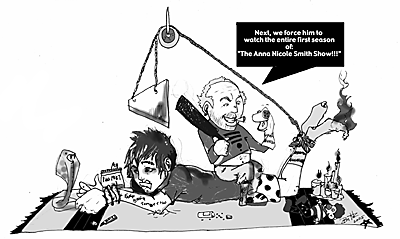
Illustration by Holly Randall
|
|
By Rui Wang
Arizona Daily Wildcat
Wednesday, February 16, 2005
Print this
There's nothing like staring at an inflatable bondage chair at the Continental Adult Shop over the lunch hour on Valentine's Day to make you positively optimistic about torture. On the front of the box, a pert and giggling school girl is tied to what looks like a giant black marshmallow with loose-fitting electrical tape. Compared to the news these days, it was almost chaste.
If only public perceptions of torture had stayed in the realm of windowless sex retailers or Hollywood epics like "Braveheart."
If the '80s were defined by excess and big hair, and if the '90s were defined by grunge and blow jobs in the Oval Office, the first half of the first decade of the 21st century has been indelibly marked by torture.
We're practically soaking in it.
The Associated Press reported last week that a released Australian terror suspect appeared on network television in his home country to talk about his experience in U.S. custody. Mamdouh Habib described being kicked by his interrogators, having cigarettes put out on his chest, being electrocuted and getting his head slammed against the floor.
Habib also recounts being tortured in a bizarrely sadomasochistic manner when a female interrogator smeared what appeared to be menstrual blood on his face. His claim is corroborated by Erik R. Saar, a former Army sergeant stationed at Guantánamo Bay, who is writing a book about interrogation methods he witnessed there. Saar wrote that in addition to the menstruation ploy, female interrogators for the U.S. military would wear salacious outfits and rub their breasts against the religiously conservative detainees in an attempt to break them down.
This follows the blow-up at Abu Ghraib prison in Iraq where U.S. soldiers arranged prisoners in naked pyramids, situated hooded men on wooden boxes with electrical clips on their fingers and led them around on dog leashes.
Not surprisingly, the culture of torture comes straight from the top. A new compilation of government reports titled "The Torture Papers" gathers together documents showing how, after the Sept. 11 attacks, the Bush administration justified the full extent of its military and intelligence operations using labels and words and language.
Government attorneys, including Alberto Gonzales, advocated that the Geneva Conventions could be circumvented by branding detainees with the arbitrary "enemy combatant" label. Those prisoners, the attorneys argued, would not be conferred traditional prisoner of war rights under international law. In addition, "Papers" shows how the term "torture" was defined as narrowly as possible in order to justify a greater range of military actions.
It's like a perverse application of the adage, "the pen is mightier than the sword."
Never mind that the U.S. position is roundly criticized by the International Red Cross, Amnesty International and just about every other country in the world. Never mind that legal scholars believe this is a dangerous precedent and may have negative consequences for our own troops that may be captured in war.
As a country, this culture of torture is bound to give us a resistance to human pain and suffering. Not only has torture entered the national consciousness through the news reports, it is also splashed across television and film.
We watch contestants torture themselves by speed-eating cow rectums on "Fear Factor" for $50,000. Before taxes. We watch women - who really only need some braces and a contact lens prescription - go on shows like "The Swan" and "Extreme Makeover" to endure weeks of excruciating plastic surgery in order to boost self-esteem.
As for Hollywood torture epics, Mel Gibson, director and star of "Braveheart," released one of the most torturous, bordering-on-sadistic films last year - "The Passion of the Christ." Gibson doesn't flinch away from showing every whip cut, every bloody lash. Smarmy web surfers dubbed the movie "The Jesus Chainsaw Massacre." The extreme violence didn't affect its box office earnings, and if Gibson's merchandising success is any indication, the kids loved it.
There's still five more years left until 2010, but I would venture to guess that the arc of torture winding its way through the decade is not complete yet.
Rui Wang is a third-year law student. She can be reached at letters@wildcat.arizona.edu.
